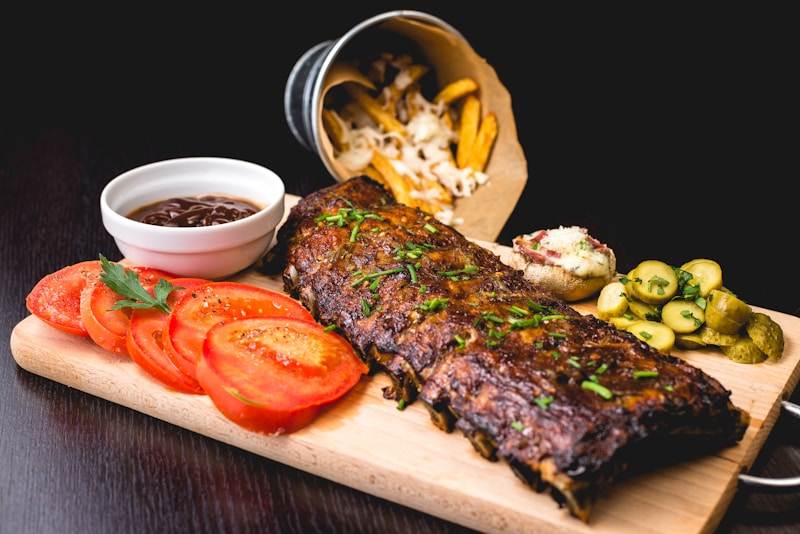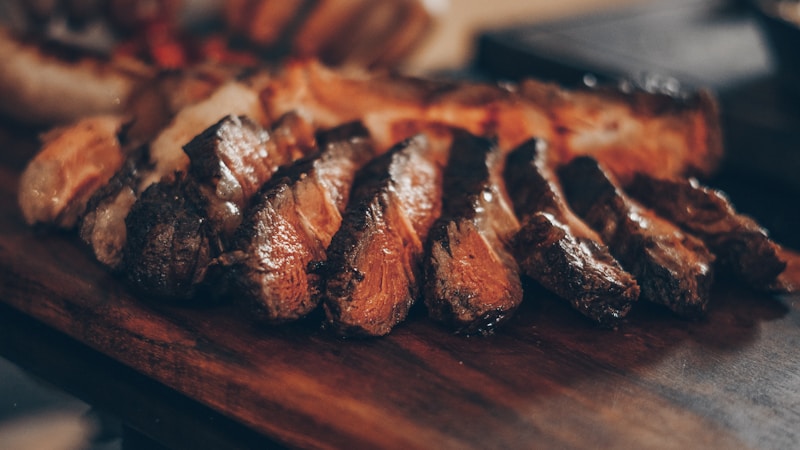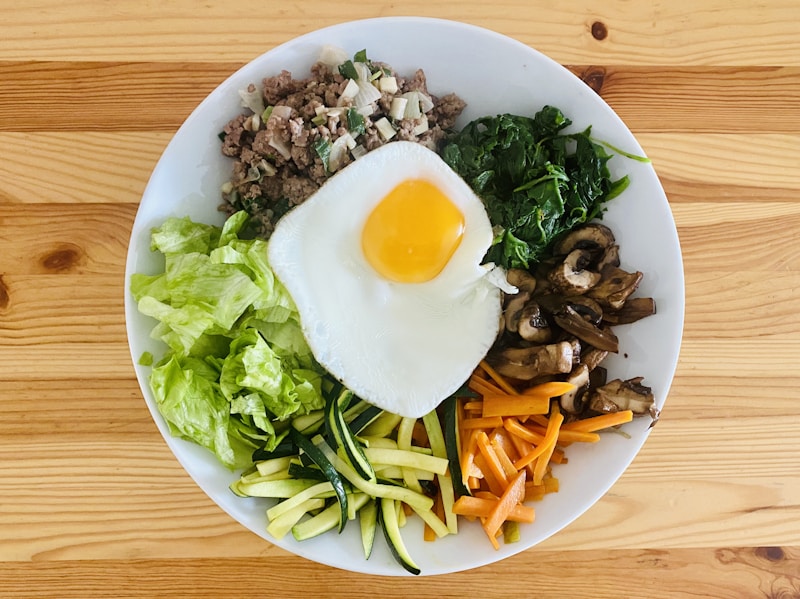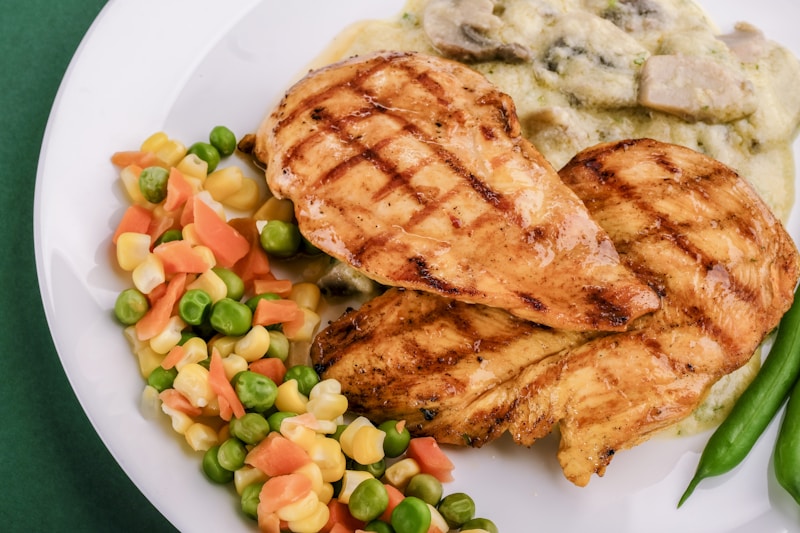🥩 How to Make a Tomahawk Steak Baguette
Transform a Premium Cut into an Unforgettable Sandwich Experience
There are sandwiches, and then there are experiences. The tomahawk steak baguette falls firmly into the latter category. This isn't your everyday lunch—it's a celebration of premium beef, crusty bread, and bold flavors that come together in perfect harmony.
The tomahawk steak, named for its distinctive long bone that resembles a Native American tomahawk axe, is essentially a bone-in ribeye with extra flair. When sliced thin and nestled into a crispy baguette with complementary toppings, it becomes one of the most impressive sandwiches you'll ever make.
Whether you're looking to impress guests, treat yourself to something special, or simply elevate your sandwich game, this guide will walk you through every step of creating this showstopper.

The impressive tomahawk steak, ready for preparation
What Makes This Sandwich Special
The beauty of a tomahawk steak baguette lies in the contrast of textures and the depth of flavors. You've got the rich, marbled beef with its incredible umami notes, the crispy-on-the-outside, soft-on-the-inside baguette, and a supporting cast of ingredients that enhance rather than overwhelm.
Unlike traditional Philly cheesesteaks or French dips, the tomahawk version celebrates the quality of the beef itself. This is about showcasing a premium cut in a format that's both elegant and satisfyingly rustic.
Ingredients You'll Need
For the Steak:
- 1 tomahawk ribeye steak (approximately 2-2.5 lbs)
- 2 tablespoons high-heat cooking oil (avocado or grapeseed)
- 3 tablespoons unsalted butter
- 4 cloves garlic, smashed
- Fresh thyme sprigs
- Coarse sea salt and freshly cracked black pepper
For the Sandwich:
- 1 large French baguette (or 2 smaller ones)
- 8 oz provolone or gruyere cheese, sliced
- 1 large red onion, thinly sliced
- 1 red bell pepper, sliced
- 1 yellow bell pepper, sliced
- 2 cups fresh arugula or baby spinach
- 2 tablespoons butter for caramelizing
- Garlic aioli or horseradish mayo (recipe below)
For the Garlic Aioli:
- ½ cup mayonnaise
- 3 cloves garlic, minced
- 1 tablespoon lemon juice
- 1 teaspoon Dijon mustard
- Salt and pepper to taste
Equipment Needed:
- Cast iron skillet or grill
- Meat thermometer
- Sharp knife for slicing
- Cutting board
- Large skillet for vegetables
- Aluminum foil

Choose a crusty French baguette with a tender interior
Step-by-Step Instructions
Take your tomahawk steak out of the refrigerator 45-60 minutes before cooking. This allows it to come to room temperature, which ensures even cooking throughout. Pat the steak completely dry with paper towels—moisture is the enemy of a good sear.
Season generously on both sides with coarse sea salt and freshly cracked black pepper. Don't be shy here; a thick steak needs bold seasoning. Press the seasonings into the meat with your hands.
For Pan-Searing:
Heat a large cast iron skillet over high heat until it's smoking hot. Add your high-heat oil and carefully place the steak in the pan. Sear for 3-4 minutes without moving it—you want a beautiful, caramelized crust.
Flip the steak and sear the other side for another 3-4 minutes. Reduce heat to medium, add butter, smashed garlic, and thyme. Tilt the pan and continuously baste the steak with the melted butter for 2-3 minutes.
For Grilling:
Preheat your grill to high heat (450-500°F). Place the steak on the hottest part of the grill and sear for 3-4 minutes per side. Then move to indirect heat and continue cooking until it reaches your desired temperature.
Temperature Guide:
- Rare: 120-125°F
- Medium-rare: 130-135°F (recommended)
- Medium: 135-145°F
Use a meat thermometer inserted into the thickest part of the steak, away from the bone. Remember that the temperature will rise 5-10 degrees during resting.

Achieving the perfect sear on your tomahawk steak
This is crucial! Transfer the steak to a cutting board, tent loosely with aluminum foil, and let it rest for 10-15 minutes. This allows the juices to redistribute throughout the meat, ensuring every bite is juicy and flavorful.
While the steak rests, the internal temperature will continue to rise slightly, and you'll end up with a more evenly cooked piece of meat.
Caramelize the Onions and Peppers:
While your steak is resting, heat butter in a large skillet over medium heat. Add the sliced onions and cook, stirring occasionally, for 15-20 minutes until they're golden brown and sweet. Add the bell peppers in the last 5 minutes of cooking. Season with salt and pepper.
Make the Garlic Aioli:
In a small bowl, combine mayonnaise, minced garlic, lemon juice, Dijon mustard, salt, and pepper. Mix well and refrigerate until ready to use. The flavors will meld together beautifully as it sits.
Slice your baguette in half horizontally. If desired, lightly toast the bread in a 350°F oven for 5-7 minutes or on the grill for 2-3 minutes. You want it warm and slightly crispy on the outside but still soft enough to bite through easily.
Don't over-toast—an overly crunchy baguette will make the sandwich difficult to eat and overwhelm the other textures.

Colorful caramelized peppers and onions add sweetness and crunch
Now for the moment of truth. Remove the meat from the bone using a sharp knife, following the contour of the bone. Slice the steak against the grain into thin strips, about ¼-inch thick. This ensures tenderness in every bite.
The grain of the meat refers to the direction the muscle fibers run. Cutting perpendicular to these fibers (against the grain) shortens them, making the meat much more tender to chew.
Now comes the fun part—building your tomahawk steak baguette:
- Spread a generous layer of garlic aioli on both sides of the baguette
- Layer the sliced steak on the bottom half
- Place cheese slices over the warm steak (the residual heat will begin melting it)
- Add the caramelized onions and peppers
- Top with fresh arugula or spinach
- Close the sandwich with the top half of the baguette
- Slice into portions and serve immediately
For an extra touch, you can place the assembled sandwich (pre-greens) back in the oven for 2-3 minutes to fully melt the cheese before adding the fresh greens.

The finished tomahawk steak baguette—a true work of art
Tips for Success
Choosing Your Steak
Look for a tomahawk ribeye with good marbling (the white fat distributed throughout the red meat). This intramuscular fat melts during cooking, creating that rich, buttery texture ribeye is famous for. Ask your butcher for a steak that's at least 2 inches thick.
Don't Skip the Resting Period
Resting is not optional—it's what separates a good steak from a great one. If you cut into your steak immediately after cooking, all those precious juices will run out onto your cutting board instead of staying in the meat.
Bread Selection Matters
A proper French baguette should have a crispy, golden crust and a soft, airy interior with large, irregular holes. Avoid soft sandwich bread or overly dense bread that will compete with your steak instead of complementing it.
Temperature Control
Invest in a good instant-read thermometer. It's the single best way to ensure your steak is cooked exactly how you like it. Visual cues alone can be misleading, especially with thicker cuts.
Serving Suggestions
This sandwich is substantial enough to be a meal on its own, but here are some excellent accompaniments:
- Crispy Fries: Classic shoestring or thick-cut Belgian fries
- Simple Salad: Mixed greens with a light vinaigrette to cut through the richness
- Pickled Vegetables: Cornichons or pickled peppers add a tangy counterpoint
- Sweet Potato Fries: For a slightly sweeter complement
- Coleslaw: Creamy or vinegar-based, adds crunch and freshness
Wine Pairing
For wine enthusiasts, a bold Cabernet Sauvignon or Malbec stands up beautifully to the rich, beefy flavors. For beer lovers, an IPA or stout provides excellent contrast.

Perfectly crispy fries make an ideal accompaniment
Common Mistakes to Avoid
- Overcooking the steak: A tomahawk ribeye is best enjoyed medium-rare to medium. Beyond that, you lose the tenderness and juiciness that make it special.
- Slicing too thick: While you want substantial pieces, slicing too thick makes the sandwich hard to eat and less tender.
- Over-toasting the bread: You want the bread to have some give. Rock-hard bread turns your gourmet sandwich into a jaw workout.
- Too many toppings: This is about showcasing quality beef. Don't bury it under excessive condiments or competing flavors.
- Forgetting to warm your bread: Cold bread next to hot steak creates an unpleasant temperature contrast.
Variations to Try
French Dip Style
Serve with a side of au jus made from the pan drippings, beef stock, and a splash of red wine for dipping. This adds an interactive element and extra flavor.
Philly Cheesesteak Inspired
Use cheese whiz or a provolone cheese sauce, add more peppers and onions, and skip the arugula for a more traditional Philly approach.
Mediterranean Twist
Replace the aioli with tzatziki, use feta cheese, and add sun-dried tomatoes and kalamata olives for a Greek-inspired version.
Spicy Version
Add sliced jalapeños, use pepper jack cheese, and mix some sriracha into your aioli for heat lovers.
Storage and Reheating
While this sandwich is best enjoyed immediately, you can store components separately:
- Cooked steak: Store sliced steak in an airtight container in the refrigerator for up to 3 days
- Vegetables: Caramelized onions and peppers keep well for 3-4 days refrigerated
- Aioli: Will last up to a week in the refrigerator
To reheat, gently warm the steak slices in a skillet over low heat with a splash of beef broth to prevent drying out. Alternatively, use a low oven (250°F) wrapped in foil. Never microwave sliced steak—it will become tough and rubbery.
Final Thoughts
Making a tomahawk steak baguette is more than just preparing a meal—it's a culinary adventure. From selecting a premium cut of beef to achieving that perfect sear, each step contributes to creating something truly special.
Yes, a tomahawk steak is an investment, but when transformed into this spectacular sandwich, it becomes an experience worth every penny. The combination of tender, flavorful beef, melted cheese, sweet caramelized vegetables, and that perfect crusty bread creates a symphony of flavors and textures that elevate the humble sandwich to art.
Whether you're making this for a special occasion, a weekend treat, or simply because you deserve something extraordinary, the tomahawk steak baguette delivers on every level. So fire up that grill or heat that cast iron skillet, and prepare to create a sandwich that will be remembered long after the last bite.


